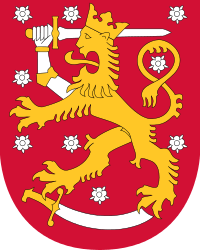Environmental issues in Finland
There are a number of environmental issues in Finland.
Climate change
Finland was among the top five greenhouse gas emitters per capita in 2001: The consumption emissions per capita of greenhouse gases in 2001 of the top 5 countries were US 29 tonnes, Australia 21 tonnes, Canada 20 tonnes, Switzerland 18 tonnes and Finland 18 tonnes.[1]
Finland is a member of the EU and thus the EU directives are binding in Finland. Finland has approved Kyoto protocol. Finland has at state level approved that human indused greenhouse gases cause global warming. Despite this the most harmful use of peat as energy has been financially promoted by Finnish government since 2005.
CO2 emissions from peat were 15% and coal and peat 39% of total fossil fuel emissions in Finland in 2006.
As part of measures by the EU to reduce greenhouse gas emissions, the European Comission asked Finland to reduce its greenhouse gas emissions by 39% by 2030.[2]
Environmental finance
The environmental finance of Finland is 0.6% of budget when OECD average is 1.7%. In September 2011, there was a proposal to cut environmental finance with 5 million € including 18% cut in the nongovernmental environmental organizations support. The finance proposal included also cut in the biodiversity support. All the main nongovernmental national environmental organizations criticized finance proposals since Finland’s finance in the environmental issues is not sufficient, the fulfillment of the EU biodiversity targets is questionable, and the peat industry receive 50-fold more state support compared to the environmental organizations.[3]
Environmental law enforcement
According to the Finnish Association for Nature Conservation (FANC) Finnish police lacks resources to investigate the environmental crimes in Finland in 2013.[4]
Phosphates
Finnish government have not denied the use of phosphates in the washing powder as was valid in Sweden and Germany at least already in 2009. State intention is to deny phosphates after the European Union directive sets the demand in 2012.[5]
Traffic
The car tax was cut in 2007 to support investments in new cars. The state arguments promised it to reduce traffic emissions by 0.37% a year. Environmental organizations considered the tax cut negative for the global warming. Politicians did nor explain, why some old cars would not remain also in the traffic and increase the overall emissions.[6] In the use of the private car the upfront costs are a higher barrier than the annual or daily costs. Most cars are imported in Finland, which increases the foreign debt.
Jorma Ollila (works for Shell) group made recommendations for future traffic of Finland in 2013. Based on this report in July 2014 it was discussed to lower the upfront costs of cars and increase the costs of the car use. This would be in the favor of the interests of the Royal Dutch Shell since according to studies the upfront costs will reduce more the traffic than the consuming taxes. Traffic poses large problems e.g. in the demand of land areas and parking places. Lower ticket prices would increase the use of Public transport. Free public transport, both cities and rural areas, could be financed by taxes from the private cars.
Mining
A large nickel mine located at Talvivaara leaked hundreds of thousands of cubic metres of tailings pond water containing toxic metals into the nearby environment in November 2012. The uranium concentration in the effluent rose by 100-200 times its normal level in the bottom and surface waters.[7] Poisonous water leaked out at a speed of 5 000-6 000 cubic metres an hour.[8] The mine has leaked also in 2008 and 2010. As a result, environmentally hazardous concentrations of nickel, zinc, cadmium and uranium were reached in the local river, exceeding the permitted yearly maximum in the environmental permit by a factor of 50.
The Dragon Mining had contaminated waters elevated levels with sulfate, nitrogen and metals in the Orivesi goldmine in March 2013. [9]
The Russian-owned Norilsk Nickel mine in Harjavalta western Finland released 66,000 kg Nickel in the local Kokemäenjoki (Kokemäki River) in July 2014. After release the nickel concentrations were 400 times normal levels. This was the largest known Ni release in Finnish history.[10][11]
References
- ↑ Which nations are most responsible for climate change? Guardian 21 April 2011
- ↑ European Commission: Finland must cut greenhouse gas emissions by 39% by 2030. helsinkitimes.fi (22 July 2016). Retrieved on 22 July 2016.
- ↑ Helsingin Sanomat 5.9.2011 C6
- ↑ Ympäristörikokset jäävät tutkimatta poliisin resurssipulan vuoksi 2013
- ↑ Suomi on kieltämässä fosfaattipesuaineet yle 5.6.2009
- ↑ Ilmastonmuutos pahin uhka kansalliselle turvallisuudelle, Luonnonsuojeluliitto 25.11.2007
- ↑ Concern over toxic leak from Europe’s largest nickel mine in north-eastern Finland November 7, 2012
- ↑ A brief update on Talvivaara toxic leak Greenpeace
- ↑ Orivesi goldmine pollutes nearby lakes yle 14.3.2013
- ↑ Environmental authority: Nickel leak threatening southwest river yle 8.7.2014
- ↑ Harjavallan nikkelipäästö Suomen historian suurin yle 8.7.2014
